1994 CHEVROLET CAVALIER fuel
[x] Cancel search: fuelPage 157 of 243
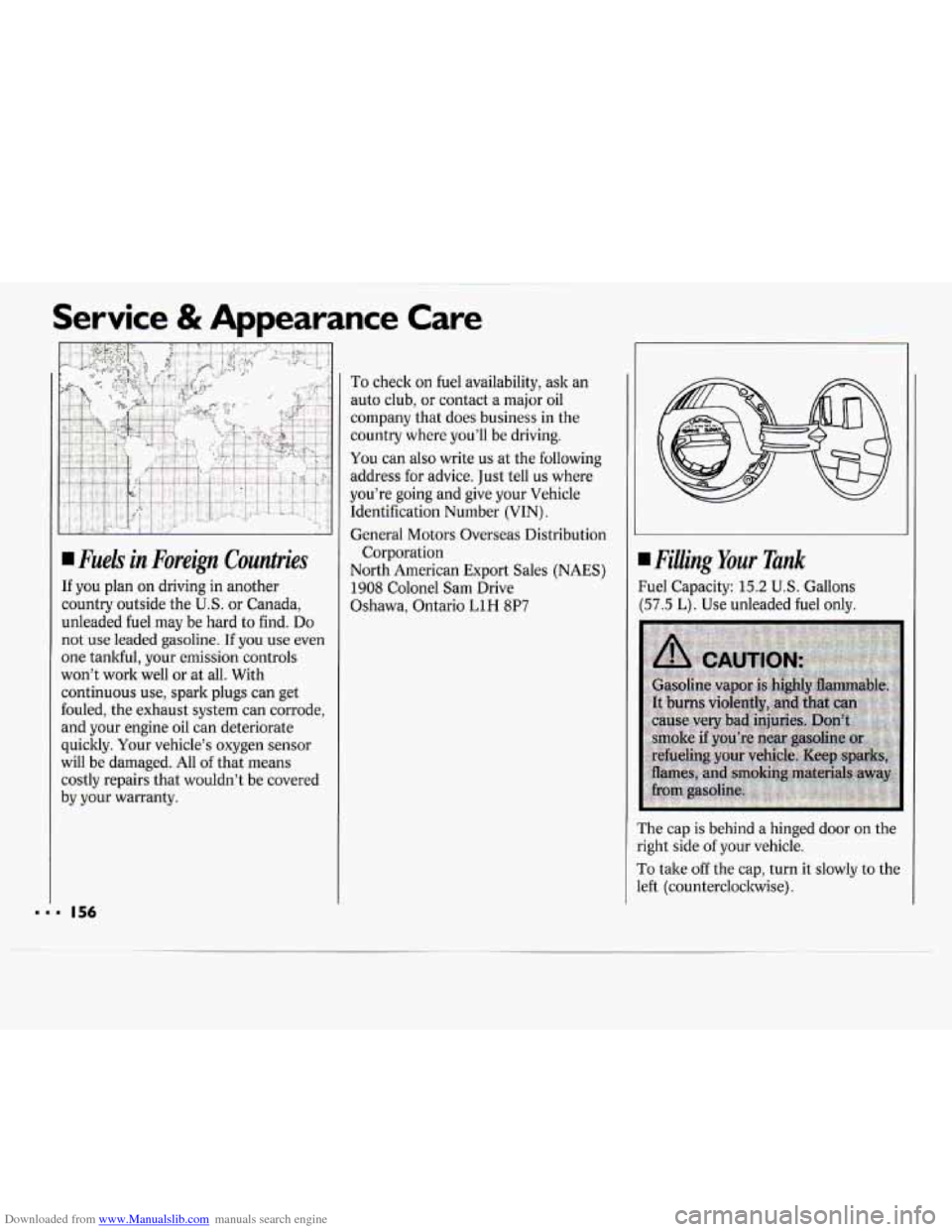
Downloaded from www.Manualslib.com manuals search engine ..
Service & Appearance Care
Fuels in Foreign Countries
If you plan on driving in another
country outside the
U.S. or Canada,
unleaded fuel may be hard to find. Do
not use leaded gasoline.
If you use even
one tankful, your emission controls
won’t work well or at all. With
continuous use, spark plugs can get
fouled, the exhaust system can corrode,
and your engine oil can deteriorate
quickly. Your vehicle’s oxygen sensor
will be damaged. All
of that means
costly repairs that wouldn’t be covered
by your warranty.
To check on fuel availability, ask an
auto club, or contact a major oil
company that does business in the
country where you’ll be driving.
You can also write us at the following
address for advice. Just tell us where
you’re going and give your Vehicle Identification Number
(VIN).
General Motors Overseas Distribution
North American Export Sales (NAES)
1908 Colonel Sam Drive
Oshawa, Ontario
L1H 8P7
Corporation Filling Your Tank
“el Capacity: 15.2 U.S. Gallons
77.5 L). Use unleaded fuel only.
The cap
is behind a hinged door on the
sight side
of your vehicle.
To take off the cap, turn it slowly to the
eft (counterclockwise).
Page 158 of 243
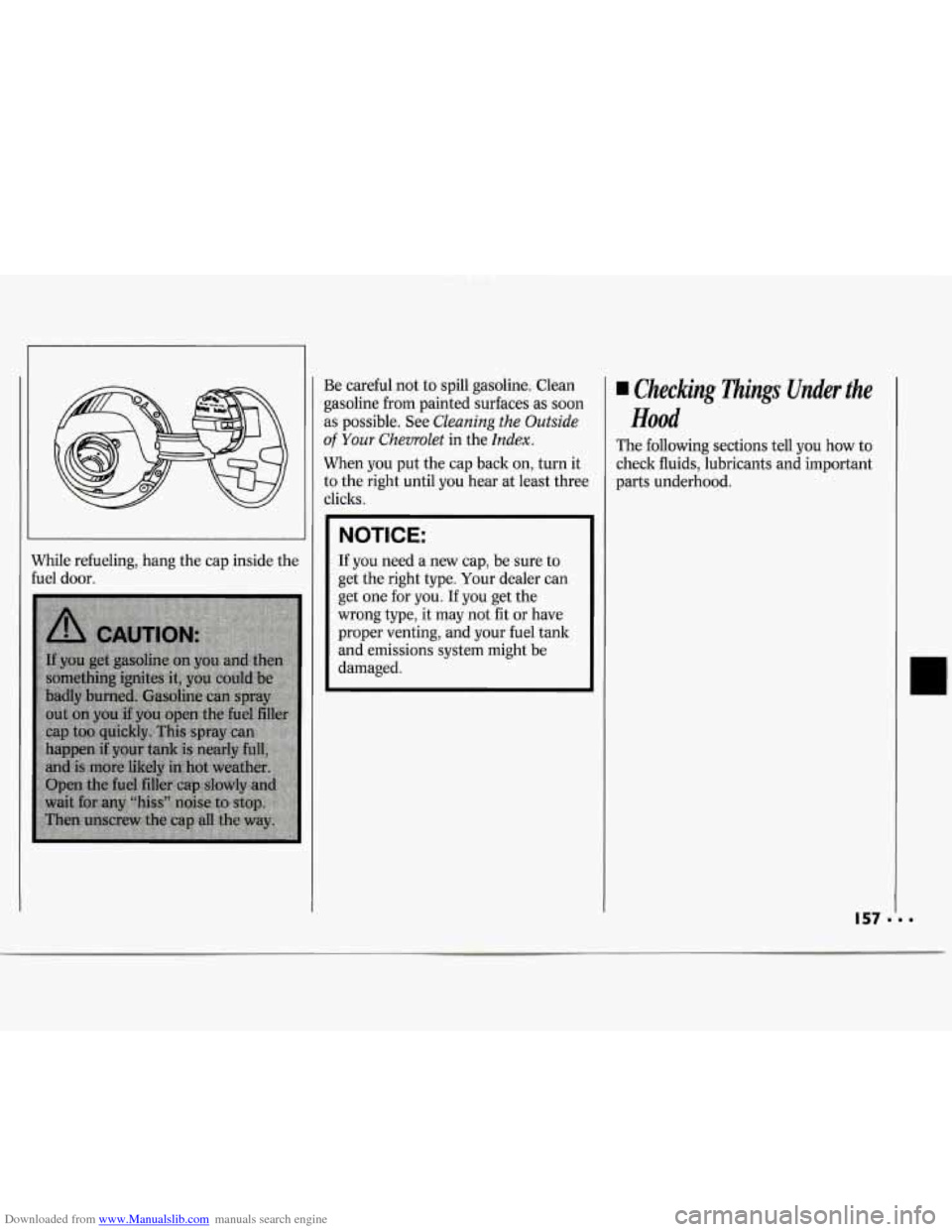
Downloaded from www.Manualslib.com manuals search engine I
While refueling, hang the cap inside the
fuel door. Be
careful not. to spill gasohe: Clean
gasoline from painted surfaces as soon
as possible. See Cleaning the Outside
of Your Chevrolet in the Index.
When you put the cap back on, turn it
to the right until you hear at least three
clicks.
NOTICE:
If you need a new cap, be sure to
get the right type. Your dealer can
get one for you.
If you get the
wrong type, it may not fit or have
proper venting, and your fuel tank
and emissions system might be
damaged.
Checking ntings Under the
Hood
The following sections tell you how to
check fluids, lubricants and important
parts underhood.
Page 163 of 243
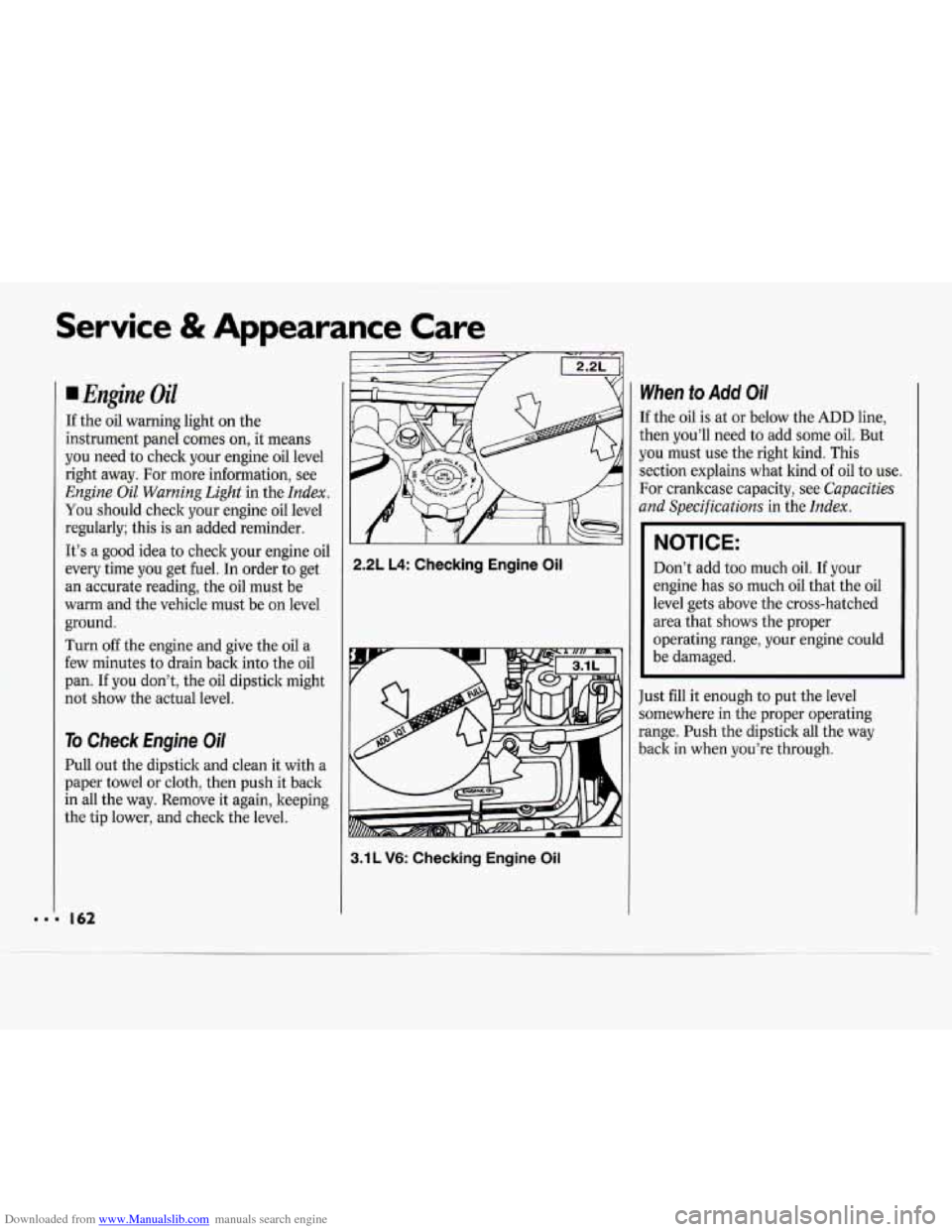
Downloaded from www.Manualslib.com manuals search engine Service & Appearance Care
Engine Oil
If the oil warning light on the
instrument panel comes on, it means
you need to check your engine oil level
right away. For more information, see
Engine Oil Warning Light in the Index.
You should check your engine oil level
regularly; this is an added reminder.
It’s a good idea to check your engine oil
every time you get fuel. In order to get
an accurate reading, the oil must be
warm and the vehicle must be on level
ground.
Turn
off the engine and give the oil a
few minutes to drain back into the oil
pan. If you don’t, the oil dipstick might
not show the actual level.
To Check Engine Oil
Pull out the dipstick and clean it with a
paper towel or cloth, then push it back
in all the way. Remove it again, keeping
the tip lower, and check the level.
2.2L L4: Checking Engine Oil
3.1 L V6: Checking Engine Oil
When to Add Oi/
If the oil is at or below the ADD line,
then you’ll need to add some oil. But
you must use the right kind. This
section explains what kind of oil to use.
For crankcase capacity, see
Capacities
and Specifications
in the Index.
NOTICE:
Don’t add too much oil. If your
engine has
so much oil that the oil
level gets above the cross-hatched
area that shows the proper
operating range, your engine could
be damaged.
Just
fill it enough to put the level
somewhere in the proper operating
range. Push the dipstick all the way
back in when you’re through.
Page 164 of 243
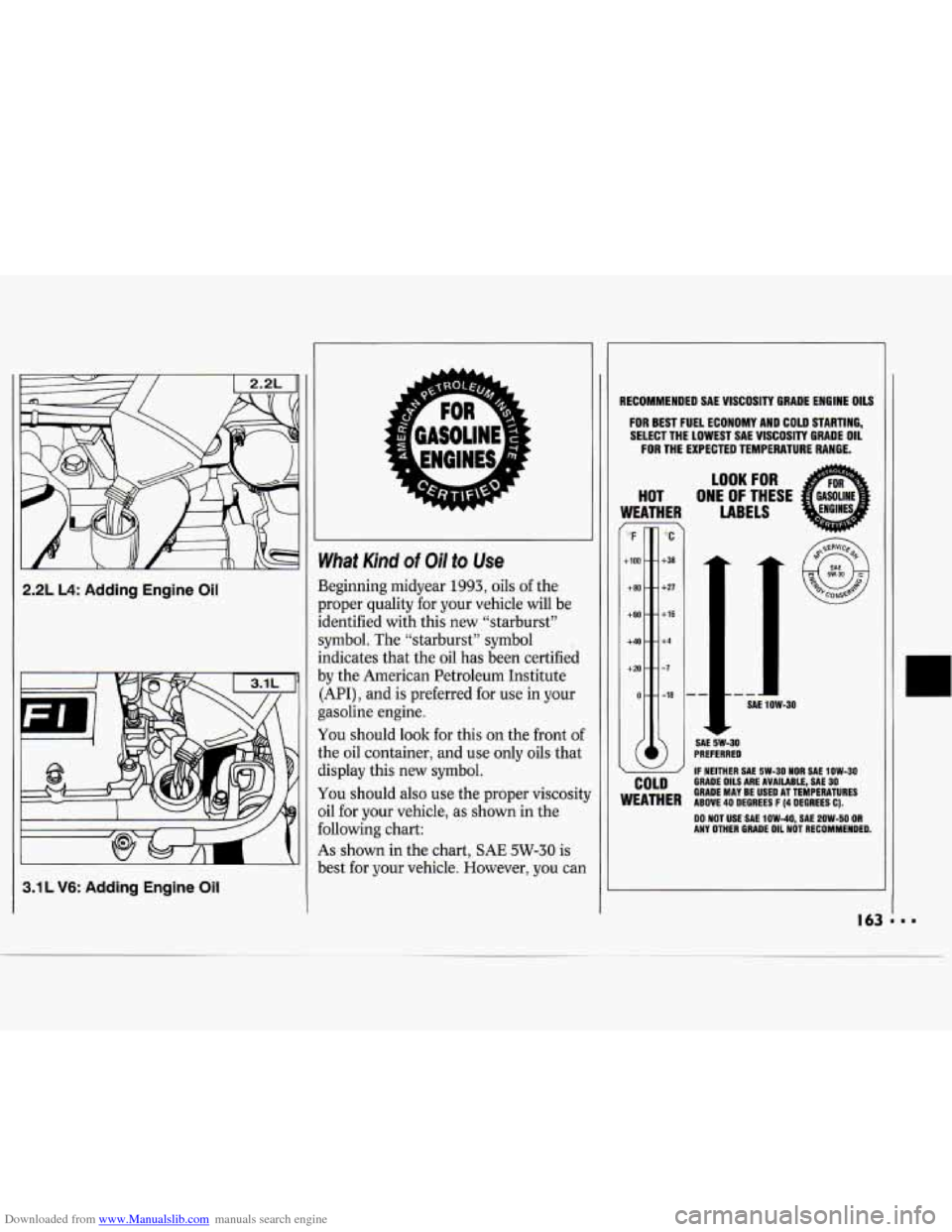
Downloaded from www.Manualslib.com manuals search engine 2.2L L4: Adding Engine Oil
3.1 L V6: Addlng Engine Oil
What Kind of Oil to Use
Beginning midyear 1993, oils of the
?roper quality for your vehicle will be
.dentified with this new “starburst”
iymbol. The “starburst” symbol
ndicates that the oil has been certified
~y the American Petroleum Institute
(API) , and is preferred for use in your
gasoline engine.
fou should
look for this on the front of
:he oil container, and use only oils that
iisplay this new symbol.
fou should also use the proper viscosit)
ail for your vehicle, as shown in the
following chart:
As shown in the chart, SAE 5W-30 is
best for your vehicle. However, you can
RECOMMENDED SAE VlSCOSlTy GRADE ENGINE OILS
FOR BEST FUEL ECONOMY AND COLD STARTING,
SELECT THE LOWEST SAE VISCOSITY GRADE
OIL
FORTHEEXPECTEDTEMPERATURERANGE.
Y
HOT
NE,
-
”F
tlOO
+ 80
+60
+40
4-20
0
’C
t38
t27
t16
t4
-1
-18
LOOK FOR
ONE OF THESE
LABELS
1
PREFERRED SAE
5W-30
IF NEITHER SAE 5W-30 NOR SAE 10W-30 COLD GRADE OILS ARE AVAILABLE, SAE 30 GRADE MAY BE USED AT TEMPERATURES WEATHER ABOVE 40 DEGREES F (4 DEGREES c).
DO NOT USE SAE 1OW-40, SAE 2OW-50 OR ANY OTHER GRADE OIL NOT RECOMMENDED.
Page 165 of 243
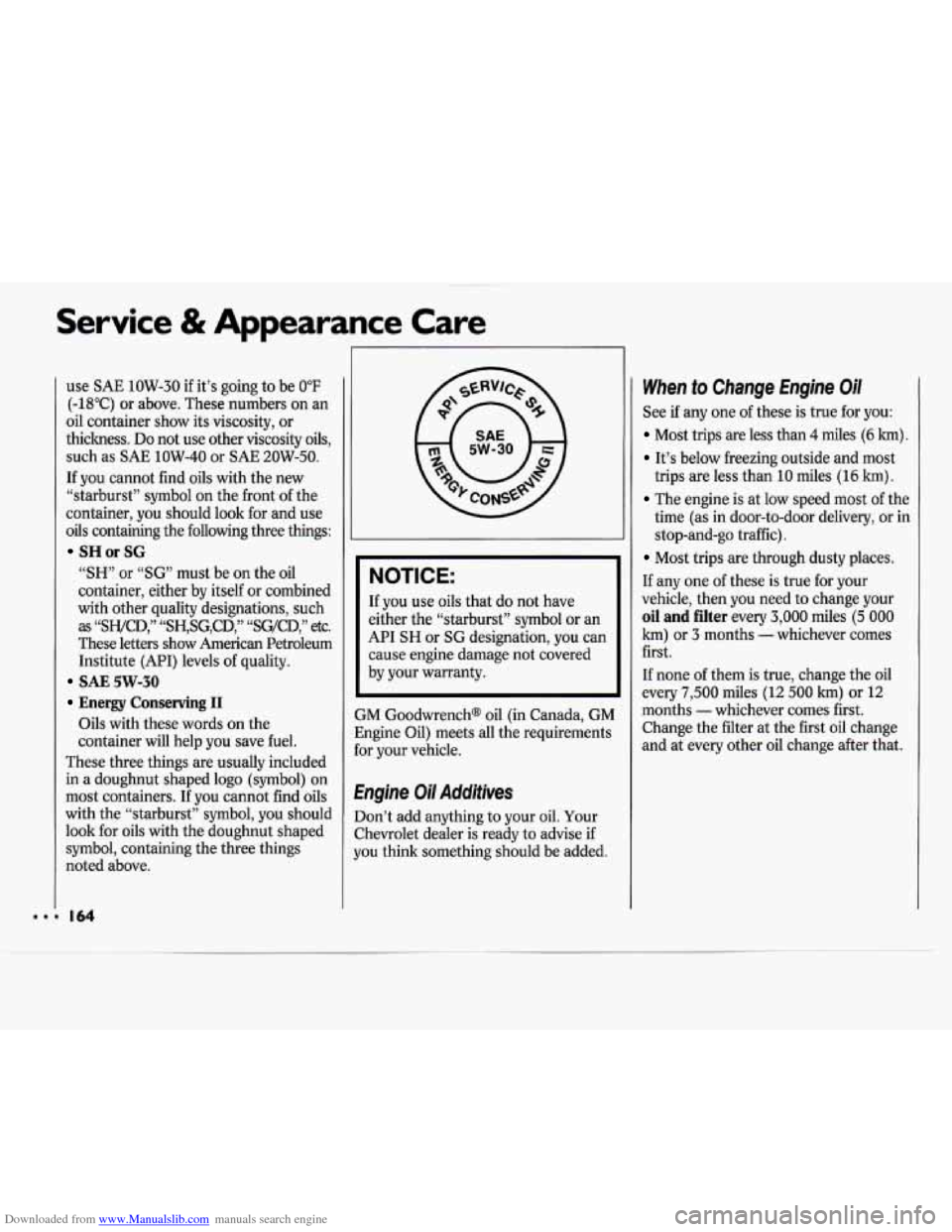
Downloaded from www.Manualslib.com manuals search engine I.
Service & Appearance Care
use SAE 1OW-30 if it’s going to be 0°F
(-18°C) or above. These numbers on an
oil container show its viscosity, or
thickness. Do not use other viscosity oils,
such as SAE 1OW-40 or SAE 20W-50.
If you cannot find oils with the new
“starburst” symbol on the front of the
container, you should look for and use
oils containing the following three things:
SH or SG
“SH” or “SG” must be on the oil
container, either by itself or combined
with other quality designations, such
as “SWCD,” “SH,SG,CD,” “SG/CD,” etc.
These letters show American Petroleum Institute (API) levels of quality.
SAE 5W-30
Energy Conserving I1
Oils with these words on the
container will help you save fuel.
These three things are usually included
in a doughnut shaped logo (symbol) on
most containers.
If you cannot find oils
with the “starburst” symbol, you should
look for oils with the doughnut shaped
symbol, containing the three things
noted above.
I64
NOTICE:
’ If you use oils that do not have
either the “starburst” symbol or an
API
SH or SG designation, you can
cause engine damage not covered
by your warranty.
GM Goodwrench@ oil (in Canada, GM
Engine Oil) meets all the requirements
for your vehicle.
€ngine Oil Additives
Don’t add anything to your oil. Your
Chevrolet dealer is ready to advise
if
you think something should be added.
When to Change Engine Oi/
See if any one of these is true for you:
Most trips are less than 4 miles (6 km).
It’s below freezing outside and most
trips are less than 10 miles (16
km) .
The engine is at low speed most of the
time (as in door-to-door delivery, or in
stop-and-go traffic).
Most trips are through dusty places.
If any one of these is true for your
vehicle, then you need to change your
oil and filter every 3,000 miles (5 000
km) or 3 months - whichever comes
first.
If none of them is true, change the oil
every
7,500 miles (12 500 km) or 12
months
- whichever comes first.
Change the filter at the first oil change
and at every other oil change after that.
Page 181 of 243
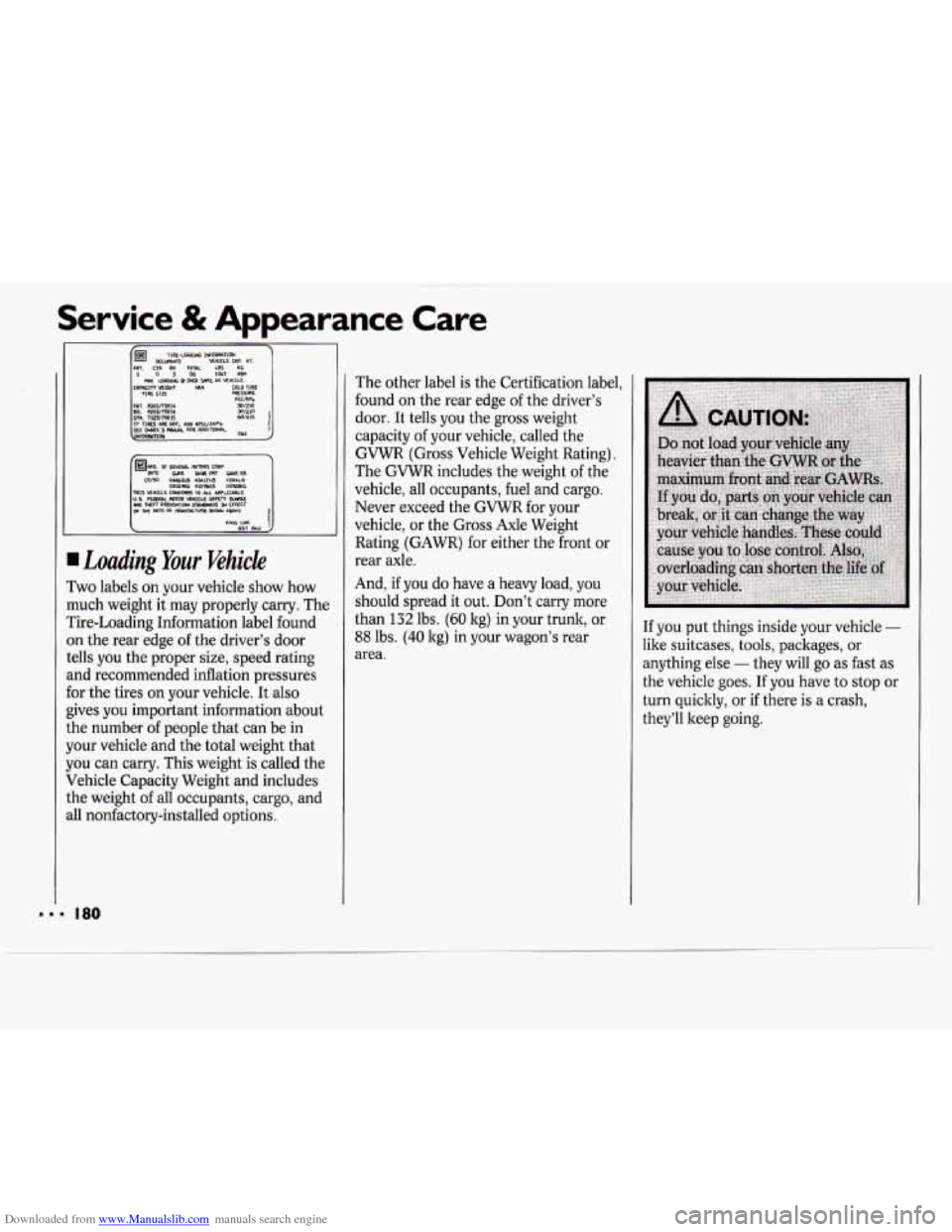
Downloaded from www.Manualslib.com manuals search engine Service & Appearance Care
I Loading Your Vehicle
Two labels on your vehicle show how
nuch weight it may properly carry. The
rire-Loading Information label found
In the rear edge of the driver's door
.ells you the proper size, speed rating
md recommended inflation pressures
or the tires on your vehicle. It also
:ives you important information about
.he number of people that can be in
four vehicle and the total weight that
rou can carry. This weight
is called the
Jehicle Capacity Weight and includes
.he weight
of all occupants, cargo, and
111 nonfactory-installed options. The other label is
the Certification label,
found on the rear edge of the driver's
door. It tells you the gross weight
capacity of your vehicle, called the
GVWR (Gross Vehicle Weight Rating).
The
GVWR includes the weight of the
vehicle, all occupants, fuel and cargo.
Never exceed the GVWR for your
vehicle,
or the Gross Axle Weight
Rating (GAWR) for either the front or
rear axle.
And, if you do have a heavy load, you
should spread it out. Don't carry more
than
132 lbs. (60 kg) in your trunk, or
88 lbs. (40 kg) in your wagon's rear
area. If you put things inside your vehicle -
like suitcases, tools, packages, or
anything else
- they will go as fast as
the vehicle goes. If you have to stop or
turn quicltly, or
if there is a crash,
they'll keep going.
Page 183 of 243

Downloaded from www.Manualslib.com manuals search engine Service & Appearance Care
Inflation-Tire Pressure
The Tire-Loading Information label
which is on the rear edge of the driver’s
door shows the correct inflation
pressures for your tires, when they’re
cold.
Cold means your vehicle has been
sitting for at least three hours or driven
no more than a mile.
NOTICE:
Don’t let anyone tell you that
underinflation
or overinflation is all
right. It’s not. If your tires don’t
have enough air (underinflation)
you can get:
Too much flexing
Too much heat
Tire overloading
Bad wear
Bad handling
Bad fuel economy.
If your tires have
too much air
(overinflation), you can get:
Unusual wear
Bad handling
Rough ride
Needless damage from road hazards.
Page 194 of 243
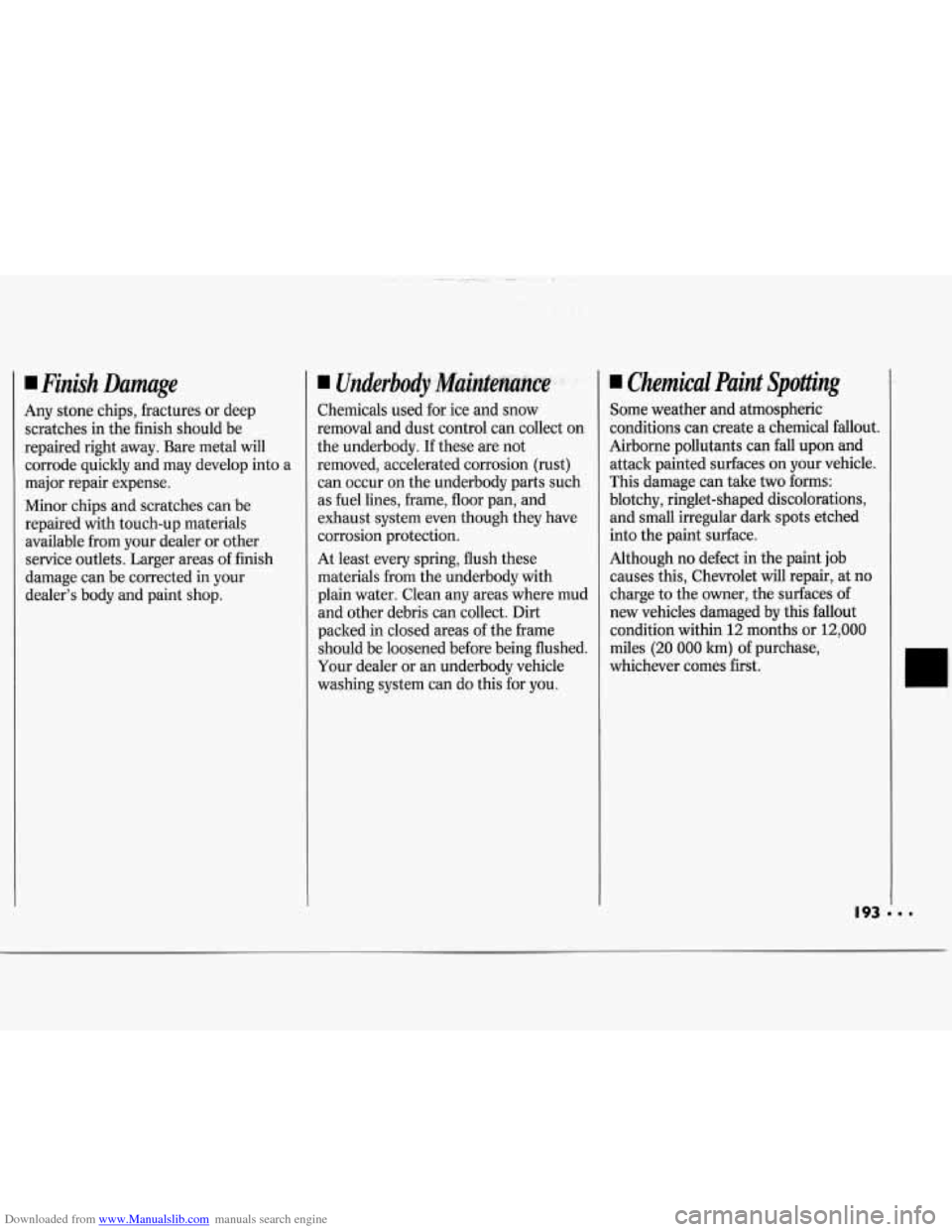
Downloaded from www.Manualslib.com manuals search engine Finish Damage
Any stone chips, fractures or deep
scratches in the finish should be
repaired right away. Bare metal will corrode quickly and may develop into a
major repair expense.
Minor chips and scratches can be
repaired with touch-up materials
available from your dealer or other
service outlets. Larger areas of finish
damage can be corrected in your
dealer's body and paint shop.
Underbody Mahtenanm . :
Chemicals used for ice and snow
removal and dust control can collect on
the underbody.
If these are not
removed, accelerated corrosion (rust)
can occur on the underbody parts such
as fuel lines, frame,
floor pan, and
exhaust system even though they have
corrosion protection.
At least every spring, flush these
materials from the underbody with
plain water. Clean any areas where mud
and other debris can collect.
Dirt
packed in closed areas of the frame
should be loosened before being flushed.
Your dealer or
an underbody vehicle
washing system can do this for you.
Chemical Paint Spotting
Some weather and atmospheric
conditions can create
a chemical fallout.
Airborne pollutants can fall upon
and
attack painted surfaces on your vehicle.
This damage can take
two forms:
blotchy, ringlet-shaped discolorations, and small irregular dark spots etched
into the paint surface.
Although no defect in the paint job
causes this, Chevrolet will repair, at no
charge to the owner, the surfaces
of
new vehicles damaged by this fallout
condition within 12 months or 12,000
miles
(20 000 km) of purchase,
whichever comes first.